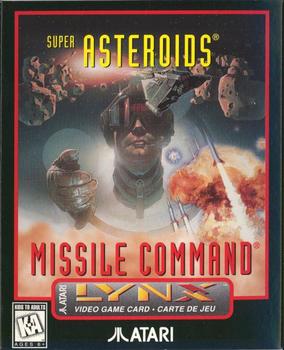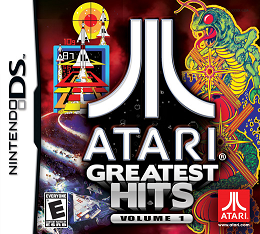Missile Command is a 1980 shoot 'em up arcade video game.
Missile Command may also refer to:
- Missile Command 3D, 1995 Atari Jaguar game
- Super Asteroids & Missile Command, 1994 Atari Lynx game
- United States Army Aviation and Missile Command
Missile Command is a 1980 shoot 'em up arcade video game.
Missile Command may also refer to:

The Atari 8-bit family is a series of 8-bit home computers introduced by Atari, Inc. in 1979 with the Atari 400 and Atari 800. As the first home computer architecture with coprocessors, it has graphics and sound more advanced than most of its contemporaries. Video games were a major appeal, and first-person space combat simulator Star Raiders is considered the platform's killer app. The "Atari 8-bit family" label was not contemporaneous. Atari, Inc., used the term "Atari 800 [or 400] home computer system", often combining the model names into "Atari 400/800" or "Atari home computers".

Missile Command is a 1980 shoot 'em up arcade video game developed and published by Atari, Inc. and licensed to Sega for Japanese and European releases. It was designed by Dave Theurer, who also designed Atari's vector graphics game Tempest from the same year. The game was released during the Cold War, and the player uses a trackball to defend six cities from intercontinental ballistic missiles by launching anti-ballistic missiles from three bases.

The Atari XE Video Game System is an industrial redesign of the Atari 65XE home computer and the final model in the Atari 8-bit family. It was released by Atari Corporation in 1987 and marketed as a home video game console alongside the Nintendo Entertainment System, Sega's Master System, and Atari's own Atari 7800. The XEGS is compatible with existing Atari 8-bit family hardware and software. Without keyboard, the system operates as a stand-alone game console. With the keyboard, it boots identically to the Atari XE computers. Atari packaged the XEGS as a basic set consisting of only the console and joystick, and as a deluxe set consisting of the console, keyboard, CX40 joystick, and XG-1 light gun.

Centipede is a 1981 fixed shooter arcade video game developed and published by Atari, Inc. Designed by Dona Bailey and Ed Logg, it was one of the most commercially successful games from the golden age of arcade video games and one of the first with a significant female player base. The primary objective is to shoot all the segments of a centipede that winds down the playing field. An arcade sequel, Millipede, followed in 1982.
In computer graphics, a sprite is a two-dimensional bitmap that is integrated into a larger scene, most often in a 2D video game. Originally, the term sprite referred to fixed-sized objects composited together, by hardware, with a background. Use of the term has since become more general.

Combat is a 1977 video game by Atari, Inc. for the Atari Video Computer System. In the game, two players controlling either a tank, a biplane, or a jet fire missiles at each other for two minutes and sixteen seconds. Points are scored by hitting the opponent, and the player with the most points when the time runs out wins. Variations on the gameplay introduce elements such as invisible vehicles, missiles that ricochet off of walls, and different playing fields.
David Theurer is a game designer and computer programmer. In 1980, he created the Missile Command and Tempest arcade games for Atari, Inc., considered two of the major releases from the Golden age of arcade games. Theurer also designed I, Robot for Atari, the first commercial video game with 3D filled-polygonal graphics.
Liberator is an arcade game released by Atari, Inc. in 1982. It is based on the Atari Force comic book series published by DC Comics from 1982 to 1986. Liberator has been described as the opposite of Missile Command, in that the player destroys cities from space instead of defending them from the ground. Only 762 arcade machines were ever made.

Atari: 80 Classic Games in One!, known as Atari Anthology on consoles, is a video game collection developed by Digital Eclipse and published by Atari Interactive. The title is a compilation of 80 video games previously published by Atari, Inc. and Atari Corporation, reproducing Atari's games from its arcade and Atari 2600 game console platforms. Many games permit one to play each title at varying speeds, with time limits, or with a shifting color palette.

Atari Anniversary Edition is a video-game compilation of Atari arcade games. It was developed by Digital Eclipse and published by Infogrames.
Rob Fulop is an American game programmer who created two of the Atari 2600's biggest hits: the port of arcade game Missile Command and 1982's Demon Attack, which won Electronic Games' Game of the Year award. While at Atari, Fulop also ported Night Driver to the 2600 and Space Invaders to the Atari 8-bit family.
Gauntletak is a multidirectional shooter video game written by Donald R. Lebeau for the Atari 8-bit family of home computers. It was released as shareware in 1984 with a full-version available for registration of US$35. Gameplay is divided into separate screens with terrain and enemies. The game was originally titled Gauntlet, but was renamed after the Gauntlet arcade game from Atari Games was released in 1985.

Football is a 1978 American football video game developed and released by Atari, Inc. for arcades. Players are represented by Xs and Os. While predated by Sega's World Cup, Football is credited with popularizing the trackball controller and is also the first non-racing vertically scrolling video game. It distributed in Japan by Namco in 1979.

The Atari Joystick Controller TV Video Game System was made in 2003 in Jakks Pacific's Plug It In & Play TV Games plug-n-play game system lineup. The device itself is designed to look like the joystick used on the Atari 2600 and has an Atari licence. It's mande in China. It was sold in Europe by Revell GmbH.

Super Asteroids & Missile Command is an Atari Lynx video game released by Atari in 1995. It combines the classic video games Asteroids and Missile Command into a single game cartridge. It was the final game released by Atari for the Lynx handheld.

The Atari Greatest Hits series is composed of two compilations of retro Atari arcade games & Atari 2600 games ported to the Nintendo DS. While listed on the Atari web site as free for iOS & Android, Atari Greatest Hits has been removed from both app stores.

Atari Vault is a collection of one hundred video games that Atari had produced for arcade cabinets and its Atari 2600 home console system, dating from the 1970s, 1980s, and 1990s. The collection was developed by Code Mystics, who had helmed similar collections of Atari games to other platforms, to work on Microsoft Windows, macOS, and Linux via the Steam client. The games, where possible, have been updated to include modern-day features such as local and online multiplayer and online leaderboards.

SethBling is an American video game commentator and Twitch video game live streamer known for YouTube videos focused around the 1990 side-scrolling platform video game Super Mario World and the 2011 sandbox video game Minecraft. He created original and derivative video games, devices and phenomena in Minecraft, without using Minecraft mods. He created an interpreter for the programming language BASIC and an emulator for the 1977 home video game console Atari 2600 in Minecraft. In addition to Minecraft builds that run without mods, he created plugins for the game.

ABM is a clone of Atari, Inc.'s Missile Command arcade game for the 32K Apple II. It was programmed by Silas Warner and published by Muse Software in 1980, the same year as Missile Command.

Missile Command 3D is a shoot 'em up video game developed by Virtuality Entertainment and published by Atari Corporation for the Atari Jaguar in North America on December 12, 1995, and Europe on December 15 of the same year. Part of Atari Corp.'s 2000 series, it is an update to Dave Theurer's 1980 arcade game Missile Command and the only officially released title that features support for the unreleased Jaguar VR peripheral.